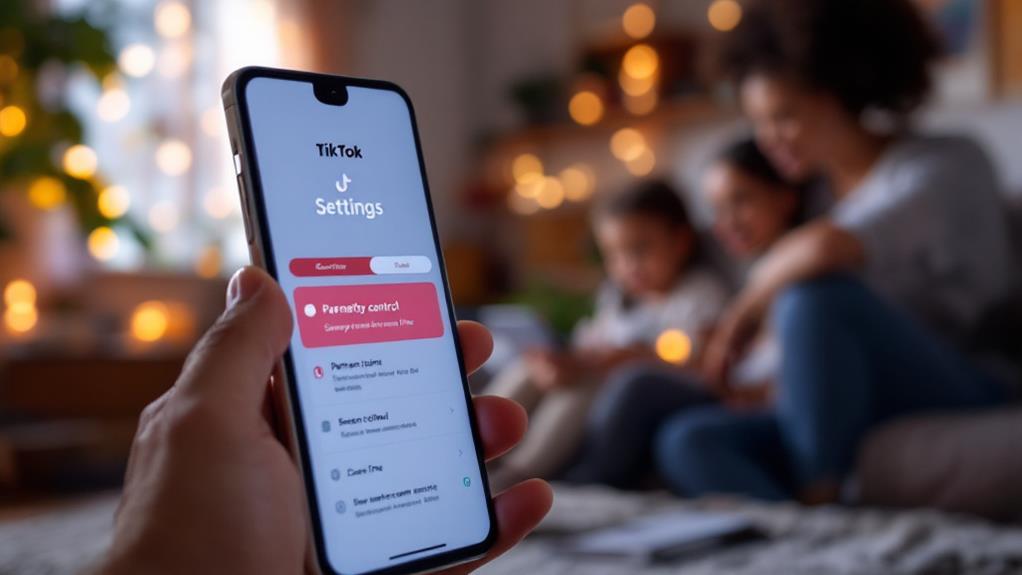Ensuring your child's safety online is a top priority for parents. Utilizing parental controls on Android can greatly aid in managing this task. The Google Family Link app offers a practical solution, allowing parents to set app download restrictions, monitor app activity, and implement screen time limits. These tools help foster responsible digital habits and protect against inappropriate content. Setting purchase restrictions and using content filters further safeguard your child's online experience. By equipping yourself with these resources, you can play a proactive role in your child's digital life, gaining more insights into effective strategies as you continue to explore.
Key Takeaways
- Utilize Family Link to set screen time limits and monitor app activity for informed discussions.
- Implement content filters and app download approvals to ensure age-appropriate access.
- Require parental approval for in-app purchases to prevent unauthorized spending.
- Block explicit content and specific apps using Family Link for added security.
- Leverage online safety resources like NSPCC for guidance on effective strategies.
Importance of Parental Controls
Recognizing the growing integration of digital devices in children's lives, the importance of parental controls on Android cannot be overstated. As digital responsibility becomes an integral aspect of modern parenting, these tools provide a thorough benefits overview that guarantees a safer online experience for children.
By managing app downloads, parents can make certain their children access only age-appropriate content, maintaining a balance between curiosity and safety. The ability to set screen time limits and device bedtime settings plays a vital role in promoting healthy digital habits, reducing screen fatigue, and supporting better sleep routines.
Furthermore, parental controls offer an insightful glance into a child's online behavior through app activity monitoring and usage reports. This not only fosters open discussions about digital responsibility but also helps parents guide their children in steering through the digital world responsibly.
Blocking explicit content and filtering inappropriate searches further enhances the child's online safety, reducing exposure to harmful material. Additionally, by requiring parental approval for in-app purchases, these controls protect family finances from unintended expenses.
Fundamentally, Android's parental controls are indispensable tools that empower parents to create a secure, structured, and responsible digital environment for their children.
Setting Up Family Link
Having highlighted the significance of parental controls, a practical approach to implementing these safeguards is through the use of Family Link on Android devices. This tool is essential in helping parents manage their child's digital experience effectively.
To begin, download the Family Link app from the Google Play Store on both the parent's and child's devices. Following the on-screen instructions facilitates the linking of the accounts, guaranteeing seamless integration and control.
Family Link features include the ability to create a Google Account for your child, which is tailored with restrictions that match their age and maturity. This customization is vital as it enables a safe online environment, filtering content to confirm age-appropriateness.
Additionally, parents have the authority to approve or block app downloads from the Google Play Store, providing an additional layer of security.
The app also offers detailed activity reports, presenting insights into how children spend their time online and highlighting frequently used apps. This information empowers parents to make informed decisions about their child's digital consumption.
Managing Screen Time
Balancing the demands of digital life with healthy habits is a challenge for many parents, and managing screen time effectively is a crucial part of this equation. Android devices, equipped with Google Family Link, provide practical screen time strategies that support healthier usage habits among children.
By setting daily screen time limits, parents can guide their children towards a balanced digital experience. The device bedtime feature is particularly useful, allowing parents to schedule when devices are off-limits, thereby promoting a consistent sleep routine—a cornerstone of healthy habits.
Furthermore, the ability to remotely lock devices offers parents a powerful tool for reinforcing boundaries. This feature enables instant restriction of device access, ensuring that screen time does not encroach upon important offline activities.
Understanding children's digital behavior is equally important, and app activity reports offer valuable insights. These reports allow parents to engage in informed discussions about time spent on educational versus recreational activities, fostering an environment of open communication.
- Set daily screen time limits: Promote balanced device use.
- Utilize device bedtime: Encourage regular sleep patterns.
- Leverage app activity reports: Gain insights into children's usage patterns.
These strategies help parents nurture a healthy digital environment for their children.
Content and Purchase Restrictions
Establishing boundaries in the digital domain is vital for safeguarding children's online experiences. With Android devices, parents can exercise significant control over the content their children interact with by implementing content and purchase restrictions. One effective measure is the requirement for app download approvals via the Google Play Store. This guarantees that children can only access age-appropriate content, protecting them from unsuitable material.
Furthermore, in-app purchase limits play an important role in preventing unauthorized and accidental spending. By requiring parental consent for in-app purchases, children learn the importance of financial awareness, while parents avoid unexpected charges. Tools like Family Link further empower parents by allowing them to block or allow specific apps, tailoring the digital environment to suit their child's needs.
In addition to app controls, content filters in Chrome can be applied to restrict access to explicit websites, thereby crafting a safer browsing experience.
Monitoring tools provide detailed reports on app activity, enabling parents to gain insights into their child's usage patterns and identify potentially harmful content early. These proactive measures help create a secure and enriching digital space, fostering responsible online habits in children.
Online Safety Resources
While parents can leverage various tools and settings on Android devices to manage content and purchases, complementing these efforts with external resources can greatly enhance a child's online safety.
Cultivating digital literacy is essential for both children and parents to understand and navigate the potential risks associated with internet use. Several organizations provide valuable resources to support this endeavor.
- NSPCC Helpline: This service offers parents guidance on teaching online safety, equipping them with strategies to protect children from harmful content and online risks.
- Internet Matters: A thorough platform that provides parents with information, tools, and age-specific advice to guarantee their children's online safety.
- UK Safer Internet Centre: Offers educational materials aimed at promoting safe and responsible internet use among children and young people.
In addition to these resources, Childline provides a dedicated section for children to learn about online safety, including issues such as cyberbullying and privacy.
The Internet Watch Foundation plays a critical role in reporting and addressing online child abuse and exploitation.
Frequently Asked Questions
How Do I Restrict My Child's Internet Access on Android?
To restrict your child's internet access on Android, implement internet filtering and app blocking via Google Family Link. This tool allows you to set screen time limits, block specific websites, and manage app permissions effectively and empathetically.
How Do I Set up Child Safety on My Android Phone?
To set up child safety on your Android phone, consider app recommendations like Google Family Link. This app enables you to manage screen time, set device usage limits, and monitor app downloads, promoting safer online experiences for your child.
Does Android Have Parental Controls?
Yes, Android offers robust parental controls through Google Family Link. This feature enables monitoring apps and setting usage limits, ensuring a safer online experience for children by regulating app downloads, tracking locations, and providing activity reports.
How to Put Child Safety on the Internet?
To enhance child safety online, implement internet safety tips such as educating about privacy settings, establishing content filters, and conducting regular online behavior monitoring. Engage in open dialogues to encourage communication about any suspicious or concerning digital interactions.
Conclusion
The implementation of parental controls on Android devices serves as a critical measure in safeguarding children in the digital domain. By utilizing tools such as Family Link, guardians can effectively manage screen time and impose content and purchase restrictions, thereby fostering a secure online environment. Access to online safety resources further enhances this protective framework, empowering caregivers to address potential threats proactively. This thorough approach not only promotes responsible digital habits but also prioritizes the well-being of young users.




